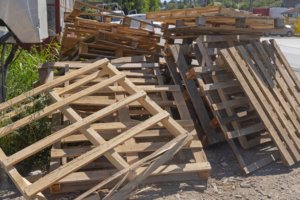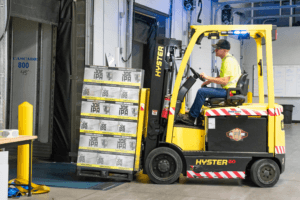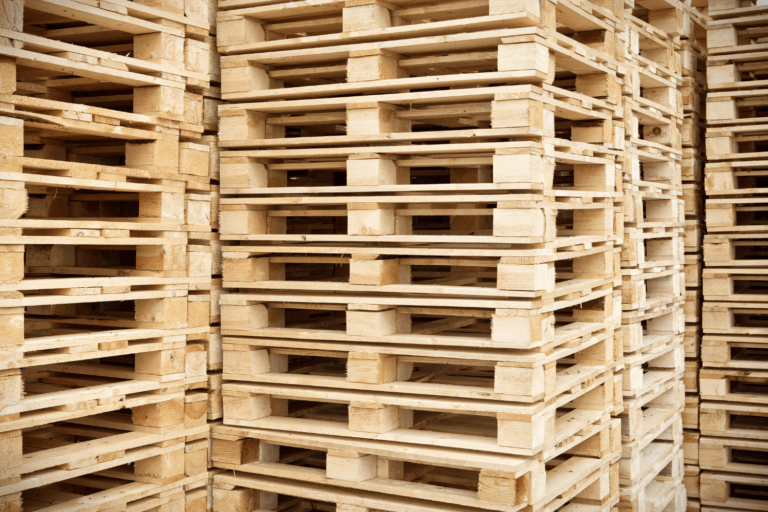A pallet jack is used in various settings, including warehouses, manufacturing facilities, retail backrooms, and loading docks.
They are typically employed for tasks like unloading trucks, moving pallets within warehouses, and positioning goods for storage or staging.
In this article, we will discuss everything you need to know about pallet jacks.
What Is a Pallet Jack?
A pallet jack, also known as a pallet truck or pump truck, consists of a set of forks, a handle, a hydraulic pump, and wheels.
The forks are inserted under a pallet, and the handle is used to pump up the forks, which lifts the pallet slightly off the ground, allowing it to be moved.
The wheels are usually made of durable materials like polyurethane or nylon to handle the weight and provide smooth movement
Pallet jacks come in two main types: manual and electric.
Manual pallet jacks rely on human power, with the operator using the handle to lift and steer the load.
Electric pallet jacks, on the other hand, use a battery-powered motor to assist with lifting and moving, which reduces physical strain on the operator.
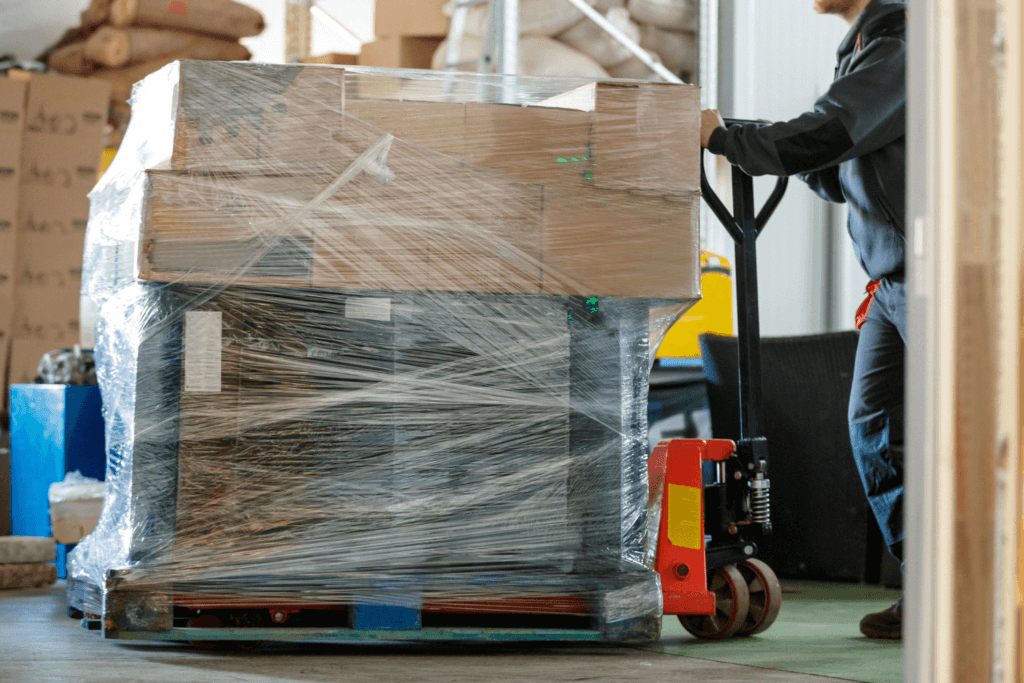
How Does a Pallet Jack Differ From a Forklift?
A pallet jack and a forklift are both essential tools in material handling, but they differ significantly in terms of design, capabilities, and suitable applications.
Each has its own set of advantages and limitations, making them more appropriate for different tasks within warehouses, manufacturing plants, and distribution centers.
Below are some of the differences between the two.
1. A Pallet Jack Is Simpler with a Basic Design
A pallet jack has two forks that slide under a pallet, a handle for lifting and maneuvering, and wheels that allow it to be moved.
They are compact, lightweight, and low-profile, allowing them to fit into narrow aisles and tight spaces.
A forklift is a larger, more complex machine that is typically powered by gas, diesel, or electricity.
It has two prongs but is mounted on a vehicle with a mast that allows for vertical lifting.
The operator controls the forklift from a seated position, using levers or buttons to raise and lower the forks, as well as move the vehicle forward, backward, and steer.
2. Pallet Jacks Have a Limited Lifting Capacity
Most manual pallet jacks can lift pallets weighing up to about 5,500 pounds (or slightly more, depending on the model), while electric pallet jacks can handle slightly heavier loads.
However, its lifting height is restricted, typically lifting only a few inches off the ground (around 3 to 8 inches) to allow for transport on flat surfaces.
Forklifts are designed for much heavier loads. They can lift loads ranging from 3,000 pounds to over 10,000 pounds, depending on the model and capacity.
They can also elevate loads to much higher heights, often up to 20 feet or more.
3. Pallet Jacks Can Navigate Tight Spaces and Narrow Aisles More Easily
Since pallet jacks are narrow and compact, they can easily navigate narrow aisles, doorways, and cramped storage areas.
They are particularly effective in smaller retail backrooms, warehouses with limited space, or areas where forklifts would be too large to operate effectively.
Forklifts require a significant amount of space due to their size and turning radius.
They are better suited for wide aisles and large facilities where they can operate without restrictions.
4. Pallet Jacks Are More Affordable Than Forklifts
Manual pallet jacks are inexpensive, and even electric models are relatively cost-effective compared to forklifts.
Maintenance costs are also lower, as they have fewer moving parts and simpler mechanisms.
Forklifts, while more capable, come with a higher upfront cost, often ranging from several thousand dollars to tens of thousands depending on the type, brand, and capacity.
They also require skilled operators with certification, adding to the cost of operation.
11 Most Common Types of Pallet Jacks
Pallet jacks are versatile and come in various designs tailored to specific needs. Below are the most common types of pallet jacks.

1. Manual Pallet Jacks
Manual pallet jacks are the simplest and most traditional type of pallet jacks.
They feature a hydraulic pump and a set of wheels, and users pump a handle to lift the forks, which hold the pallet slightly off the ground.
They are limited by the strength of the user and are best suited for smaller spaces, where heavy lifting or long distances aren’t necessary.
2. Electric Pallet Jacks
Electric pallet jacks enhance the basic functionality of manual jacks by incorporating an electric motor, allowing for easier movement and lifting.
They require less manual effort. With a push-button interface, they reduce operator strain and improve efficiency in high-volume settings.
However, they are more expensive and require regular charging and maintenance.
3. Rider Pallet Jacks
Rider pallet jacks take electric jacks a step further by allowing operators to stand on a platform attached to the machine, enabling quicker transportation.
These are ideal for large warehouses or facilities with long aisles.
4. High-Lift Pallet Jacks
High-lift pallet jacks are designed to elevate pallets to greater heights than standard pallet jacks.
They are particularly useful for tasks that require workers to load or unload at waist or chest height, improving ergonomics and reducing strain.
They typically use a scissor-lift mechanism and can lift pallets up to approximately 32 inches.
5. Weighing Pallet Jacks
Weighing pallet jacks come equipped with built-in scales. This feature is invaluable in settings where precise load weight measurements are required.
These jacks eliminate the need to move pallets to a separate scale.
6. Low-Profile Pallet Jacks
Low-profile pallet jacks are designed for pallets or skids with lower-than-standard clearance heights. Their forks can reach as low as 2 inches.
They are often used in manufacturing or automotive environments where equipment or components are set on specialized pallets.
7. Galvanized or Stainless Steel Pallet Jacks
Galvanized or stainless steel pallet jacks are crafted to withstand harsh environments. They resist moisture and corrosive substances.
Stainless steel versions, in particular, are resistant to bacteria and easy to clean, making them ideal for industries with strict sanitation requirements.
8. Rough Terrain Pallet Jacks
Rough terrain pallet jacks can handle uneven or outdoor surfaces.
Featuring larger, more durable wheels, these jacks can navigate gravel, dirt, or other rough terrains that standard pallet jacks would struggle with.
They are typically manual and built with reinforced frames to handle heavier, bulkier loads.
9. All-Terrain Pallet Jacks
All-terrain pallet jacks go a step beyond rough terrain models. They are built for use on any surface.
They feature reinforced frames, pneumatic tires, and higher ground clearance, allowing them to maneuver across both rough and smooth surfaces.
10. Scissor Lift Pallet Jacks
Scissor lift pallet jacks combine pallet transport with a lifting mechanism that raises the load much higher than standard jacks.
The scissor lift design allows them to raise pallets up to waist or shoulder height, making them useful in manufacturing and assembly line applications.
They are more complex and costly and require careful handling due to their elevated lifting capability.
11. Foldable Pallet Jacks
Foldable pallet jacks are designed for easy storage and transport, as they can be folded to take up less space when not in use.
They often come with a lighter frame and are best suited for handling lighter loads over short distances.
While they lack the heavy-duty capacity of other pallet jacks, their portability and space-saving design make them an excellent choice for mobile operations.
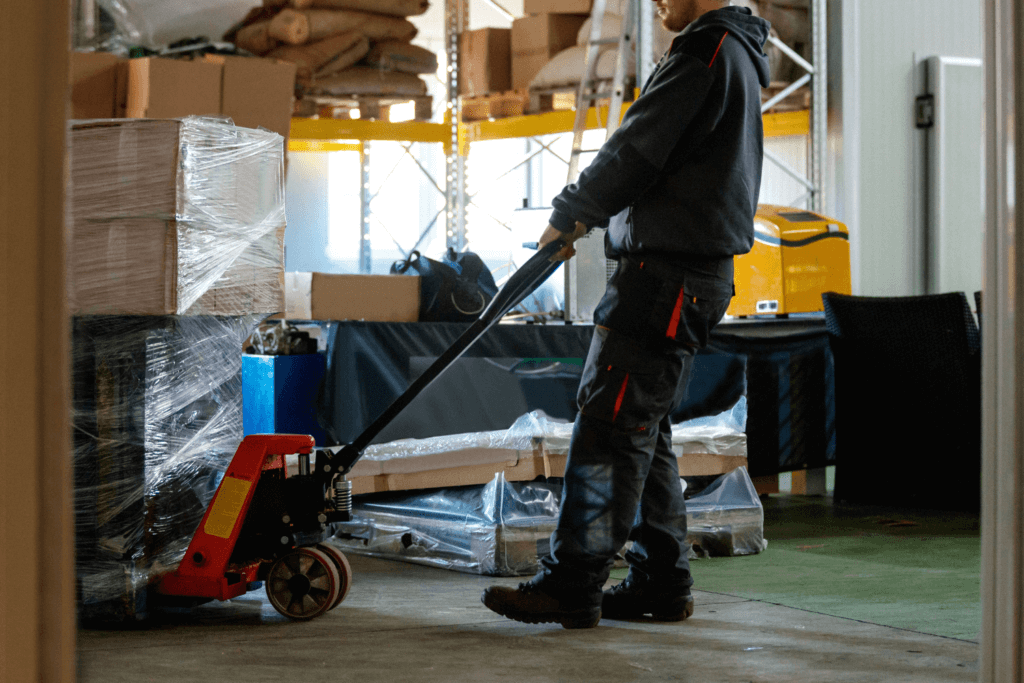
When Is It Best to Use a Pallet Jack?
Pallet jacks are typically employed for tasks like unloading trucks, moving pallets within warehouses, and positioning goods for storage or staging.
Due to their limited lifting height and transport capacity, they are best suited for short-distance movement and operations involving lighter to moderate loads.
Learn more about the situations where a pallet jack may be the best equipment to use.
1. You Are Moving Lightweight or Moderate Loads
Manual pallet jacks require physical effort, so they are more suitable for lighter loads. If you need to handle moderate weights, you can use electric models.
When compared to forklifts, they offer a practical, cost-effective alternative for smaller tasks.
This is particularly advantageous in industries where the loads tend to be lighter, and frequent, quick movements are necessary.
2. Space Is Limited and Precision Is Necessary
When working in confined spaces, such as narrow aisles, tight corners, or small storerooms, pallet jacks are an excellent choice due to their compact size and maneuverability.
They can be used to make tight turns and precise movements. This helps reduce the risk of accidental damage to surrounding equipment or products.
3. You Want Equipment That Is Simple to Operate with Minimal Training
A pallet jack is one of the easiest material handling equipment to learn and operate, requiring only minimal training.
Their controls are intuitive, with most manual models relying on a simple pump handle to lift and lower loads.
Electric pallet jacks may require basic operational training, but they are also designed to be user-friendly, often with push-button controls.
4. You Have a Limited Budget
Pallet jacks are an economical alternative to more costly equipment, such as forklifts, making them a smart choice if you have a limited budget.
A manual pallet jack has low purchase costs and minimal maintenance needs.
Electric pallet jacks are more expensive initially, but they still cost significantly less than forklifts and come with lower operational and maintenance costs.
How Much Does a Pallet Jack Cost?
The most basic models of pallet jacks have basic features and a weight capacity of around 5,500 pounds. They can cost between $200 and $400.
Models designed to handle heavier loads, up to 6,000 pounds or more, may range from $400 to $600.
Electric pallet jacks, also known as powered pallet trucks, are battery-operated and can help with lifting and moving heavier loads with less physical effort.
These are ideal for more demanding environments but can cost over $2,000.
Pallet jacks with specific features such as high-lift functionality, weighing capabilities, or rough terrain capabilities usually start at $600.
If you are looking for a more cost-effective option, used or refurbished pallet jacks can be a great alternative.
Used manual pallet jacks can cost between $100 and $400, depending on the condition and brand.
Electric pallet jacks can be found in the range of $1,500 to $4,000 for used models, but prices vary based on age, condition, and brand reputation.

Conclusion
Pallet jacks are popular due to their simplicity and cost-effectiveness. They require minimal training and are more affordable than other heavy machinery.
They can also navigate tight spaces and narrow aisles more easily than larger equipment, making them ideal for environments where space is restricted.
If you want to learn how to operate a pallet jack, read this guide. If you need assistance, check out our solutions here.
Chesapeake Pallets has been helping companies across the United States level up their logistics, one pallet at a time.
For inquiries, email info@chesapeakepallets.com or request a quote below!



